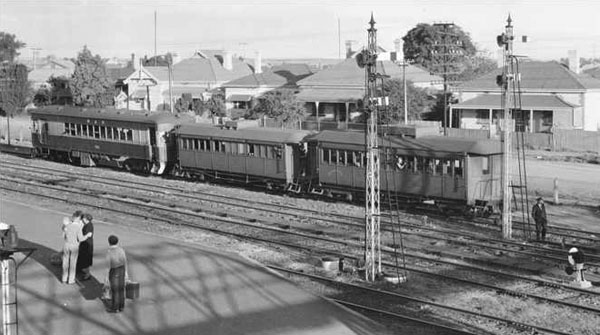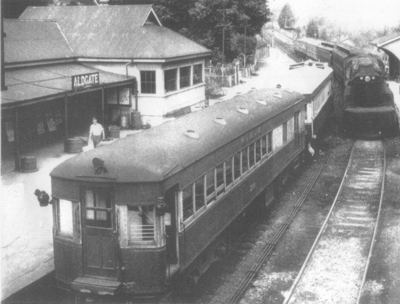In the late 1920s thirty-five J.G. Brill Company (Philadelphia, USA) model 75 railcars and a number of trailers were introduced onto the South Australian Railways (SAR) by Commissioner Webb following the successful operation of twelve smaller model 55 railcars. These cars had already achieved acclaim by speeding up branchline services formerly operated by steam hauled mixed trains. In deference to the politics of the day, and no doubt helped by the unusual sound of their air hooter, they were dubbed "Barwell's Bulls". Sir Henry Barwell was the State Premier directly responsible for the appointment of Webb, an eminently qualified American railwayman, whose task was to rehabilitate the SAR system.
A pattern car, broad gauge No. 30, was fully imported but subsequent cars were assembled at the SAR's Islington Workshops on imported frames. Seven cars, 100 to 106 were built on narrow frames for narrow gauge workings.
A firm favourite with rail fans, the railcars could be found on both broad and narrow gauge lines in most parts of the State. Generations of high school students used them to travel to and from school (Crystal Brook and Booleroo Centre areas in the north for example) in the days before proliferation of school buses. To the farmers they were the means of sending eggs and cream away from the farm, when the railway was still a common carrier and a community service. Country people travelled to the city in them for dental appointments, or just for a shopping outing, in the days before the private motor car became a ubiquitous means of travel.
In 1936 car 103 and trailer 303 on the Port Lincoln division received a new cream and green colour scheme in association with the State Centenary celebrations. Subsequently all of the cars had their red-brown scheme upgraded to the new scheme.

Technical specifications (powered railcars)
| Engine (when built) | Winton 6 cyl petrol | |
|---|---|---|
| Power | 186 hp | 139 kW |
| Engine (after 1960) | Cummins 6 cyl diesel | |
| Power | 234 hp | 175 kW |
| Weight | 24 tons | 24.4 t |
| Length | 59 ft | 18 m |
Representatives in the Pichi Richi Railway collection
Power cars
106
.jpg)
Railcar 106 entered service on 17 March 1928 on the then narrow gauge lines of the SAR's South-East Division.
It was transferred to Peterborough in the mid 1930s, where it spent much of its time between Terowie and Quorn until the railcar service ceased on 31 January 1969. During the gauge conversion between Peterborough and Terowie it saw some service and was then transferred to Islington before being condemned on 17 August 1976.
With its original power plant—a 186 hp (138 kW) six cylinder Winton petrol engine—it clocked up 1,138,658 miles (1,833,227 km). After the fitting of a Cummins NHS-6b diesel engine in 1960 it travelled another 278,511 miles (448,499 km), giving a grand total of 1,417,221 miles (2,281,726 km) in 48 years of service.
Back in 1977 the Pichi Richi Railway Preservation Society (PRRPS) discovered that railcar 106 was still in existence, stored out of the way at Islington. Although lacking an engine, it was the last remaining potentially serviceable Brill railcar and immediate steps were taken to ensure its preservation. It was purchased by PRRPS on 23 March 1977 and eventually reached Quorn in February 1978.
Railcar 106 entered service with PRRPS in 1990 following its restoration. The project was supported by The Savings Bank of South Australia (now BankSA) with a donation of $7,000.
| Builder | South Australian Railways, Islington Workshops under licence from J.G. Brill Company |
|---|---|
| Entered service | 17 March 1928 |
| Builder’s number | |
| Withdrawn from service | 19 February 1969 |
| Distance travelled in service | 1,138,658 miles (original petrol engine) 278,511 miles (diesel engine) 1,417,221 miles (total) |
| Acquired by PRRPS | 1977 |
| Notes | Fitted with improved seating 15 October 1935 |
| PRRPS operational status | Operational |
Trailer cars
219

This is a trailer car of the same body type as the 75 class railcars. Built to narrow gauge specifications by the South Australian Railway (supplied by J.G. Brill and Co. in kit form), the car was required for use on the broad gauge. The bodies being almost identical, the only change needed was to fit broad gauge bogies.
The car entered service in December 1928, and was used on broad gauge for its entire service under the SAR, and ran with the road number 219.
On 17 March 1972, the car was converted for use as a workmans' sleeping car, and issued the road number PWS26. It remained in that configuration until purchased by PRR, and restoration commenced.
PRRPS returned trailer 219 to service on 6 October 2001. The car was renumbered to 305 by PRRPS (this vehicle never carried the number 305 in SAR service), being the next number for a narrow gauge trailer (although the number 304 was not actually used). It is the first Brill trailer to be restored to service by an Australian railway preservation society.
Internally, the car has the same seating arrangement other narrow gauge trailers, finished with 42 seats and a baggage compartment. For PRRPS service the baggage compartment has been fitted out with a servery, to allow refreshments and souvenirs to be sold during the journey.
301
Trailer car 301 entered service on 16 November 1928 on the narrow gauge Peterborough Division of the South Australian Railways. In August 1930 it was converted to broad gauge trailer 220.
It was converted to permanent way vehicle PWS30 in 1969 for use as accommodation for track maintenance gangs.
302
302 was also initially issued to the SAR's Peterborough Division. It entered service on 28 November 1928. Its seating arrangement was altered in 1932 to give it a back-to-back seating configuration.
It was converted to permanent way vehicle PWS31 circa 1970.
